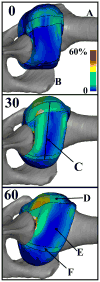Finite element modelling of the glenohumeral capsule can help assess the tested region during a clinical exam
- PMID: 20013435
- PMCID: PMC3769951
- DOI: 10.1080/10255840903317378
Finite element modelling of the glenohumeral capsule can help assess the tested region during a clinical exam
Abstract
The objective of this research was to examine the efficacy of evaluating the region of the glenohumeral capsule being tested by clinical exams for shoulder instability using finite element (FE) models of the glenohumeral joint. Specifically, the regions of high capsule strain produced by glenohumeral joint positions commonly used during a clinical exam were identified. Kinematics that simulated a simple translation test with an anterior load at three external rotation angles were applied to a validated, subject-specific FE model of the glenohumeral joint at 60° of abduction. Maximum principal strains on the glenoid side of the inferior glenohumeral ligament (IGHL) were significantly higher than the maximum principal strains on the humeral side, for all three regions of the IGHL at 30° and 60° of external rotation. These regions of localised strain indicate that these joint positions might be used to test the glenoid side of the IGHL during this clinical exam, but are not useful for assessing the humeral side of the IGHL. The use of FE models will facilitate the search for additional joint positions that isolate high strains to other IGHL regions, including the humeral side of the IGHL.
Figures


Similar articles
-
Methodology and sensitivity studies for finite element modeling of the inferior glenohumeral ligament complex.J Biomech. 2007;40(3):603-12. doi: 10.1016/j.jbiomech.2006.01.024. Epub 2006 Mar 31. J Biomech. 2007. PMID: 16580002
-
Stress and strain in the anterior band of the inferior glenohumeral ligament during a simulated clinical examination.J Shoulder Elbow Surg. 2005 Jan-Feb;14(1 Suppl S):24S-31S. doi: 10.1016/j.jse.2004.10.003. J Shoulder Elbow Surg. 2005. PMID: 15726084
-
In-vivo glenohumeral translation and ligament elongation during abduction and abduction with internal and external rotation.J Orthop Surg Res. 2012 Jun 28;7:29. doi: 10.1186/1749-799X-7-29. J Orthop Surg Res. 2012. PMID: 22741601 Free PMC article.
-
Inferior glenohumeral ligament (IGHL) complex: anatomy, injuries, imaging features, and treatment options.Emerg Radiol. 2017 Feb;24(1):65-71. doi: 10.1007/s10140-016-1431-0. Epub 2016 Aug 16. Emerg Radiol. 2017. PMID: 27530740 Review.
-
Application of finite element analysis in shoulder diseases: A systematic review.Asian J Surg. 2023 Jul;46(7):2834-2835. doi: 10.1016/j.asjsur.2023.01.094. Epub 2023 Feb 6. Asian J Surg. 2023. PMID: 36754737 No abstract available.
Cited by
-
[Prognostic evaluation of hip joint function following capsule repair based on a threedimensional finite element analysis model].Nan Fang Yi Ke Da Xue Xue Bao. 2020 Dec 30;40(12):1826-1830. doi: 10.12122/j.issn.1673-4254.2020.12.20. Nan Fang Yi Ke Da Xue Xue Bao. 2020. PMID: 33380395 Free PMC article. Chinese.
-
Finding consistent strain distributions in the glenohumeral capsule between two subjects: implications for development of physical examinations.J Biomech. 2011 Feb 24;44(4):607-13. doi: 10.1016/j.jbiomech.2010.11.018. Epub 2010 Dec 7. J Biomech. 2011. PMID: 21144519 Free PMC article.
-
Efficient development of subject-specific finite element knee models: Automated identification of soft-tissue attachments.J Biomech. 2025 Jan;178:112441. doi: 10.1016/j.jbiomech.2024.112441. Epub 2024 Nov 26. J Biomech. 2025. PMID: 39615057
-
Finite element analysis of the rotator cuff: A systematic review.Clin Biomech (Bristol). 2020 Jan;71:73-85. doi: 10.1016/j.clinbiomech.2019.10.006. Epub 2019 Oct 23. Clin Biomech (Bristol). 2020. PMID: 31707188 Free PMC article.
-
Effects of simulated injury on the anteroinferior glenohumeral capsule.Med Biol Eng Comput. 2012 Dec;50(12):1299-307. doi: 10.1007/s11517-012-0961-1. Epub 2012 Oct 5. Med Biol Eng Comput. 2012. PMID: 23054378 Free PMC article.
References
-
- Bankart ASB. The pathology and treatment of recurrent dislocation of the shoulder joint. Br J Surg. 1938;26:23–9.
-
- Bigliani LU, Pollock RG, Soslowsky LJ, Flatow EL, Pawluk RJ, Mow VC. Tensile properties of the inferior glenohumeral ligament. J Orthop Res. 1992;10:187–97. - PubMed
-
- Bokor DJ, Conboy VB, Olson C. Anterior instability of the glenohumeral joint with humeral avulsion of the glenohumeral ligament. A review of 41 cases. J Bone Joint Surg Br. 1999;81:93–6. - PubMed
-
- Brenneke SL, Reid J, Ching RP, Wheeler DL. Glenohumeral kinematics and capsulo-ligamentous strain resulting from laxity exams. Clin Biomech (Bristol, Avon) 2000;15:735–42. - PubMed
Publication types
MeSH terms
Grants and funding
LinkOut - more resources
Full Text Sources
